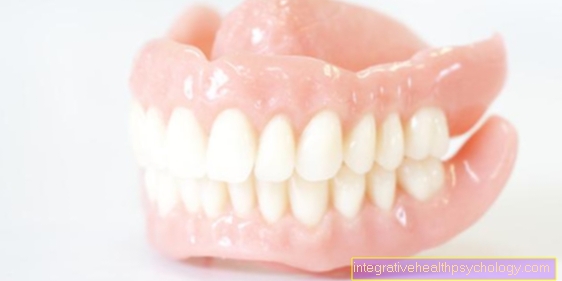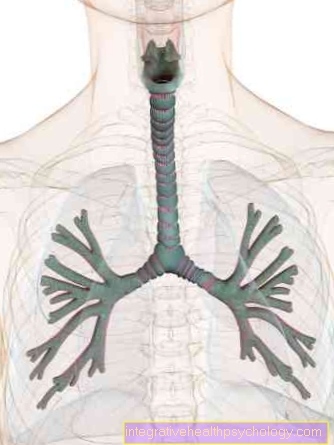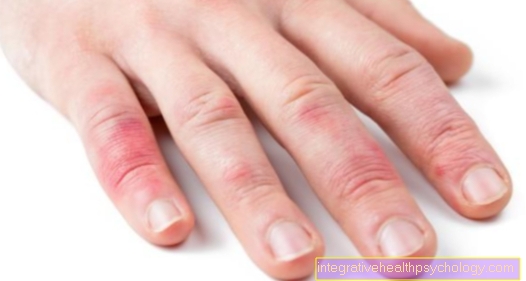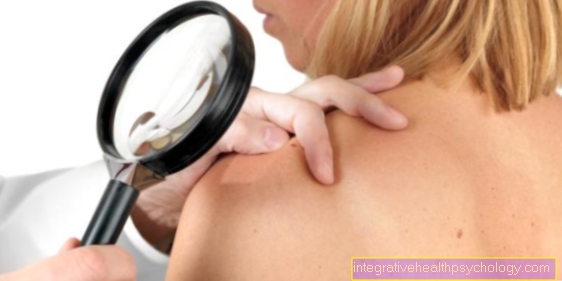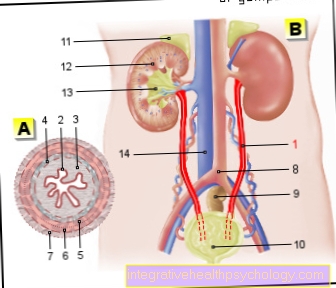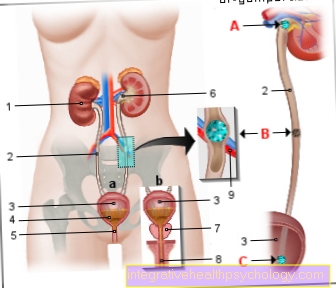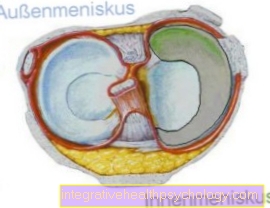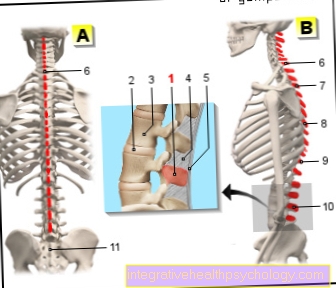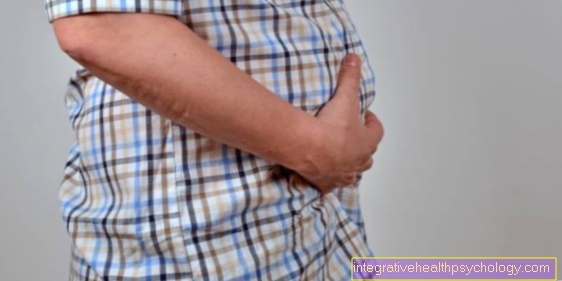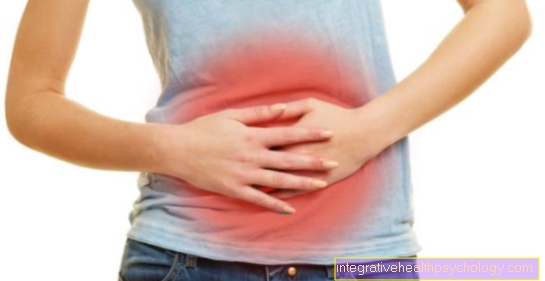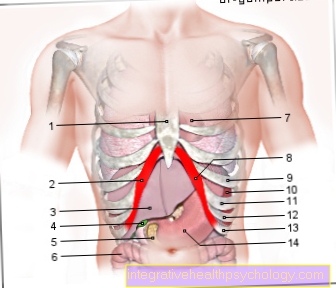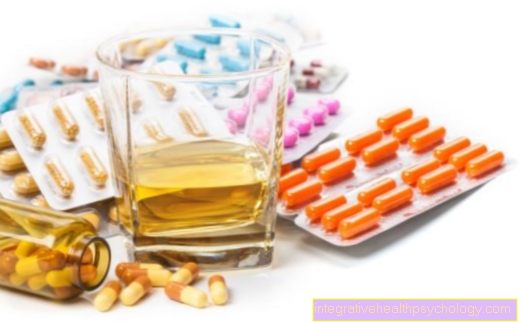Medicine cabinet - emergency medication & first aid kit
introduction
A list of all conceivable emergency medication would be almost infinite in view of the fact that virtually all diseases can cause an emergency. In the following you will find an overview of the most common medications that are used in emergencies, as well as all other utensils that are used for first aid supplies. A distinction should of course be made between drugs that are suitable for the "home pharmacy" and those that an emergency doctor carries with him.
The following information is intended to provide a general overview. At the end of the sections you will find a reference to the main article of the respective drug.

Medicines for the medicine cabinet
Painkiller
NSAIDs (Ibuprofen, Diclofenac and Co)
"NSAID" stands for non-steroidal anti-inflammatory drugs. These are a class of well-known pain medication such as ibuprofen or diclofenac (Voltaren®). NSAIDs inhibit an enzyme that produces signal substances in the body that are involved in pain and inflammatory reactions, among other things. Therefore, in addition to the pain-relieving effect, they also have an anti-inflammatory effect and are particularly suitable for joint pain. An antipyretic effect can also be observed. The main side effect of NSAIDs is that it inhibits the production of gastric mucus, which can make the lining of the stomach prone to diseases such as inflammation of the lining of the stomach or a stomach ulcer. If NSAIDs are taken for a long time, so-called acid blockers ("Proton pump inhibitors"), such as pantoprazole.
For details, see NSAIDs, ibuprofen and Diclofenac.
Acetylsalicylic acid (ASA, Aspirin®)
Acetylsalicylic acid, better known as ASA or as the trademark Aspirin®, is also one of the NSAIDs. A special feature of ASA, however, is that it inhibits coagulation and is therefore also used as a "blood-thinning" drug, for example in patients who have suffered a heart attack. Because of its blood-thinning effect, it has now been replaced by the above-mentioned substances when used purely for pain relief. Furthermore, caution should be exercised when using ASA in children, as the so-called Reye's syndrome can occur in these as a rare side effect. Another side effect is the inhibition of gastric mucus production (see above) with ASA.
For details, see Aspirin®.
Paracetamol
Paracetamol inhibits the same enzyme ("COX") in the body as the NSAIDs and thus has a similar effect to this, but chemically does not belong to this group. Paracetamol is best known for its strong antipyretic effect and is also popular for administration to children, for example as an antipyretic juice. Overdosing with paracetamol affects the liver, which is why paracetmol should not be taken in conjunction with alcohol. The maximum dose for adults is 4 grams per day.
For details, see Paracetamol.
Antipyretic effect
As already described above, some painkillers (especially paracetamol, ibuprofen, ASA) have an antipyretic effect. This is because the signal substance that is responsible for pain stimuli in the body and that is inhibited by pain medication also plays a role in the development of fever. The classic for lowering fever, especially in children, is the active ingredient paracetomol. Paracetamol is also available for children in age-appropriate dosage forms as suppositories or feverish juice.
You can find detailed information on our website How can you lower a fever?
Nausea medication and travel tablets
Vomex® / dimenhydrinate
Vomex® is a well-known trade name for the active ingredient Dimenhydrinate. This is used for nausea and is also contained in many travel tablets. He belongs to the group of antihistamines, which are known to a wide audience for their use in allergies or hay fever. In the brain, however, the signaling substance histamine is also involved in triggering nausea, which is why these active substances are also suitable for treating motion sickness, for example. A side effect that is sometimes desired is that antihistamines cause tiredness, which makes falling asleep on long bus trips or the like. facilitated.
For details, see Nausea medication and Vomex®
Metoclopramide / MCP
Metoclopramide is a prescription-only anti-nausea drug, which is why it is not a typical part of the simple medicine cabinet. It counteracts the development of nausea in the brain by inhibiting the signaling substance dopamine. It also speeds up the processes and the passage of food in the gastrointestinal tract, which has an anti-nausea effect. However, it should only be used strictly according to the doctor's prescription. For example, young children must not take metoclopramide.
For details, see Metoclopramide (MCP).
Medication for a cold
Nasal spray
There are many different nasal sprays with different active ingredients that are used for a cold or runny nose. Seawater nasal sprays contain table salt and serve to moisten the nasal mucous membrane and liquefy the mucus. Decongestant nasal sprays usually contain the active ingredient Xylometazoline, by which the vessels of the nasal mucous membrane contract and this swells. Also cortisone can be contained in nasal sprays and have an anti-inflammatory effect. Furthermore works Dexpanthenol, which is known for its use in Bepanthen®, protects the nasal mucosa. However, nasal sprays should not be used for more than a week as they can be addictive!
Well-known representatives of nasal sprays for colds or the like. are Otriven® and Nasic®.
For details, see Nasal spray, Otriven® and Nasic®.
Cough remover
Cough relievers are designed to make it easier to cough up mucus that forms as part of respiratory diseases. To do this, they stimulate the formation of secretions in the respiratory tract or "draw" water from the mucous membrane into the mucus in order to liquefy it. There are plant-based cough removers that include May contain ivy, such as Prospan®. However, active pharmaceutical ingredients can also be used to dissolve the cough. These include, for example, ACC akut® (active ingredient Acetylcysteine) or Mucosolvan® (active ingredient Ambroxol).
For details, see Cough remover.
Sinupret®
Sinupret® drops or Sinupret® forte in tablet form are herbal medicines. They are used to treat sinus infections that can occur with a cold. Sinupret® contains a mixture of the herbal active ingredients verbena extract, elderflower, primrose blossom, sorrel extract and gentian root extract. This mixture has a decongestant effect on the mucous membrane of the sinuses and thus alleviates the symptoms.
For details, see Sinupret® drops and Sinupret® forte.
Sore throat tablets
There are some preparations that can be used as tablets or lozenges for sore throats. Typically these tablets contain several active ingredients. This usually includes the so-called Lidocaine, which numbs the lining of the throat and thus directly inhibits the sore throat. But also active ingredients that have an antiseptic or antibacterial effect and fight the pathogens of sore throats are contained in many sore throat tablets, for example Amyl metacresol and Dichlorobenzyl alcohol.
Well-known representatives of tablets for sore throats are Locastad® and neo-angin®, which takes place Lidocaine the cooling one Levomenthol contains for pain relief.
For details, see Locastad® and neo-angin®.
Medication for diarrhea

Loperamide
Loperamide is an active ingredient that inhibits bowel movements (peristalsis) and therefore counteracts diarrhea. It is also known as a "peristalsis inhibitor". Loperamide is one of the opiods, but only works peripherally via opioid receptors in the intestine and has no effect on the central nervous system in the commercial dosage. However, it is only approved for children aged 12 and over. It should also not be taken during breastfeeding. If there is bloody diarrhea, which indicates an acute bacterial intestinal infection, loperamide should not be taken. Because the bacteria should rather leave the intestine with the stool than stay in it longer.
Probably the best-known brand for loperamide is Imodium®.
For details, see Loperamide and Imodium®.
Perenterol®
Perenterol® is a drug that consists of certain yeasts (so-called. Saccharomyces boulardii). These yeasts settle in the intestinal mucous membrane and thereby inhibit the colonization with pathogenic bacteria. This supports the natural intestinal flora. Perenterol® is normally used to treat acute diarrhea, but can also be used to prevent traveler's diarrhea.
For details, see Perenterol®.
Electrolyte mixtures
With severe diarrhea, the body loses a lot of fluids and electrolytes in a short time, which can lead to significant complications, especially in older patients and infants. In the event of persistent or severe diarrhea, electrolyte mixtures can therefore be purchased at the pharmacy, with which the electrolyte balance of the body can be replenished. The mixtures contain, among other things, potassium and sodium chloride. Oralpädon® and Elotrans® are among the best-known preparations.
Detailed information on Electrolyte mixtures and a Overview on the mentioned and other drugs can be found at Medication for diarrhea.
Medicines for abdominal pain
Omeprazole / pantoprazole
Omeprazole and pantoprazole are among the so-called proton pump inhibitors, which are also known as acid blockers. They inhibit the production of excess gastric acid and thus prevent over-acidification of the stomach and the associated irritation of the gastric mucosa. They are used for all diseases that are associated with hyperacidity of the stomach or where this should be avoided. These include Heartburn / reflux, inflammation of the stomach lining or stomach ulcer.
As already described above, they are also used preventively in the event of prolonged administration of drugs that inhibit gastric mucus production. These include pain relievers such as ibuprofen, ASA or diclofenac.
For details, see Proton pump inhibitors, omeprazole and Pantoprazole.
laxative
Laxatives, also known as laxatives, can be used to treat abdominal pain caused by constipation. A well-known representative of this group is, for example, lactulose. Lactulose osmotically draws water into the intestines, making the stool softer, which can make bowel movements easier and clear constipation.
The active ingredient bisacodyl, which e.g. is contained in the preparation Dulcolax®. The active ingredient inhibits the absorption of water from the intestines, which also liquefies the stool.
For details, see Laxatives, lactulose and Dulcolax®.
Buscopan®
Buscopan® contains the active ingredient butylscopalmin and is mainly used for cramp-like abdominal pain. The active ingredient inhibits the contraction of the inner muscles of the abdominal organs and thus relieves "abdominal cramps". Since the active ingredient inhibits a signal substance or the target receptor, which is distributed almost everywhere in the body, a wide range of side effects can occur in the event of an overdose. These include dry mouth, nausea and vomiting. Patients with chronic pre-existing conditions should ask their doctor or pharmacist for advice before taking butylscopalmin.
For details, see Buscopan®.
Medicines for allergies
Antihistamines
Antihistamines inhibit the signaling substance histamine, which is mainly involved in triggering an allergic reaction. Simple allergies such as hay fever or even slight allergic reactions to insect bites can be easily controlled with antihistamines. Antihistamines can theoretically have far-reaching side effects, since histamine functions almost everywhere in the body. In addition to the onset of fatigue, they are usually well tolerated.
Widely used and non-prescription representatives of antihistamines are, for example, cetirizine and dimetindene (Fenisitl®).
For details, see Antihistamines, cetirizine and Fenistil®.
Allergy emergency kit
An emergency kit for allergic shocks, so-called anaphylactic shocks, does not belong in everyone's medicine cabinet. However, if a family member has a known severe allergy, for example to foods such as peanuts or fish, an appropriate emergency kit should definitely be available. It makes sense that everyone living in the household should be familiar with the use of the emergency kit. Emergency anaphylaxis kits usually contain an adrenaline injector ("adrenaline pen"), cortisone, and an antihistamine. The declaration of use and the prescription should be made by a specialist!
For details, see Allergy emergency kit.
bronchial asthma
The therapy of bronchial asthma is very extensive and takes place according to a graduated scheme with many different drugs, depending on how severe the disease is. Therefore, no general recommendations for the medicine cabinet can be given, the medication should be carried out individually by the treating specialist. Usually, patients with mild to moderate asthma always have an asthma spray on hand for the acute situation. This contains a drug that dilates the bronchi and thereby alleviates the symptoms. Typically, it is the active ingredient salbutamol or a related one.
For details, see Salbutamol.
Other medicines for the medicine cabinet
Nitroglycerin spray
Nitroglycerin spray is a drug for absolute emergency situations and is therefore more likely to be found on ambulances. It has a strong vasodilating effect and is used for symptoms such as angina pectoris (e.g. in the context of a heart attack) or blood pressure derailments. Therefore, patients with poorly controlled blood pressure occasionally have a nitro spray at home in order to counteract a blood pressure derailment in an emergency.
For details, see Nitroglycerin.
First aid kit for the home
A first-aid kit should contain plenty of first-aid materials to treat minor injuries and to adequately cover larger injuries that require medical treatment, at least temporarily. Road users are obliged to carry a first aid kit, the contents are also strictly regulated. For our first-aid kit at home, we can orientate ourselves on their contents. In the following, the content has been supplemented by some classics that are used in everyday life:
Sterile compresses
Compresses of various sizes cover wounds aseptically and can also be used to apply ointments. The wound pad is fixed with a plaster and then wrapped with a gauze bandage. For example, you can stop the flow of blood by applying light pressure on the wound.
Gauze bandages
Gauze bandages of various widths are used to fix wound dressings such as sterile compresses. There are elastic and self-adhesive gauze bandages which, in addition to compression, are also suitable for immobilizing body parts after an injury.
In the so-called bandage packs, the wound pad is directly connected to a gauze bandage. It is used for the initial treatment of large wounds and is fixed with a plaster strip or a bandage clip.
Hemostatic cotton wool
In the case of slight superficial bleeding or nosebleeds, hemostatic cotton can also be used at home. The natural product stimulates the body's own blood clotting and thus stops the bleeding.
For details, see Hemostatic cotton wool.
band Aid
Plasters of all sizes or cut-to-size plaster rolls should not be missing in any first-aid kit. This can be used to cover smaller (previously cleaned) injuries and to fix bandages and compresses on the skin.
Bandage clip
In contrast to plasters, bandage clips are reusable and easier to remove. It has spikes on the underside and is used to fix bandages.
Finger bandage
A finger bandage is a prefabricated bandage for treating injuries to the finger. The finger cots are pulled over the previously fixed sterile wound cover and slowly rolled out. Through a small incision you get a bandage strip, which you pull off and cut to the base of your finger, then the strip is knotted on each side of the forearm. A finger bandage should protect the finger, but still allow enough freedom of movement.
Hose bandages
Similar dressings come in different sizes for adults and children. They can be used to treat injuries to hands and arms or feet and legs.
Triangular scarf
The triangular scarf is also part of the first-aid kit. It is a triangular cotton cloth, usually white. Since it is a non-sterile bandage, it is not suitable as a wound cover! The triangular scarf is used, for example, to tie an arm sling and immobilize a limb.
Bandage scissors
Bandage scissors belong in every first aid kit. It is used for cutting to size and removing bandages. The lower blade is rounded, this protects the patient from injuries when removing even tight-fitting bandages. Bandage scissors should be made of stainless steel and rust-free, and should also be disinfected after use.
tweezers
Splinter forceps are suitable for removing small splinters of wood in the skin. Care must be taken to remove the splinter as completely as possible, especially at great depth. Otherwise the wound may become infected.
Tick tweezers
You should also have a tick tweezer at home. The animal should be removed completely without crushing it and without leaving its head in the skin.
Cold compresses
The PECH rule applies to sports injuries: break, ice (cooling!), Compression and elevation. In contrast to cooling compresses, instant cold compresses do not have to be stored in the freezer compartment; pressure makes the compress cold and can be used immediately (once). Cold sprays are also useful.
Disinfectants
Disinfectants are used to kill pathogens. They are suitable for disinfecting the hands before manipulating a wound, for cleaning the same or for disinfecting aids such as bandage scissors. In the initial care of wounds, disinfection is necessary to prevent germs from entering the wound, which can lead to infections. There are a number of disinfectants which differ in their spectrum of activity and in some cases do not cover all pathogens. For first aid at home or on the go, you should have the following disinfectants ready: Povidone iodine, e.g. contained in betaisodona ointment and high percentage alcohol (NOT for use on the skin, only for disinfecting instruments, as it irritates and burns the skin!).
For details, see Disinfectants and Betaisodona.
Disposable gloves
Hygienic work, especially with open injuries, also includes gloves. When driving, for example in the event of an accident, you should wear disposable gloves, especially before coming into contact with foreign blood, to protect yourself and the victim from infections.
Clinical thermometer
Especially if you have children in the house, taking a temperature can be an important measure for the early detection and follow-up of diseases. Make sure that you insert the clinical thermometer correctly so that the measured temperature does not deviate from the actual temperature. The rectal measurement is the most accurate. It shouldn't be missing in the medicine cabinet.
Exclusion of liability / disclaimer
We would like to point out that medication must never be discontinued, applied or changed independently without consulting your doctor.
Please note that we cannot claim that our texts are complete or correct. The information may be out of date due to current developments.


